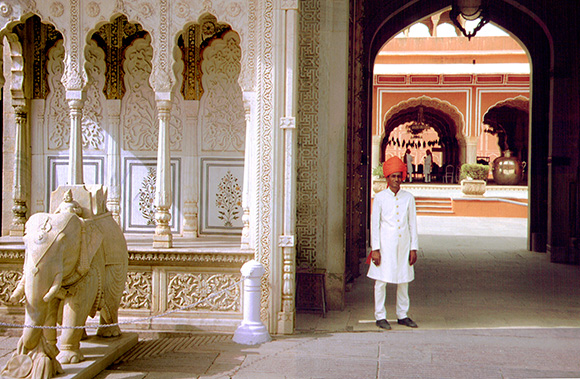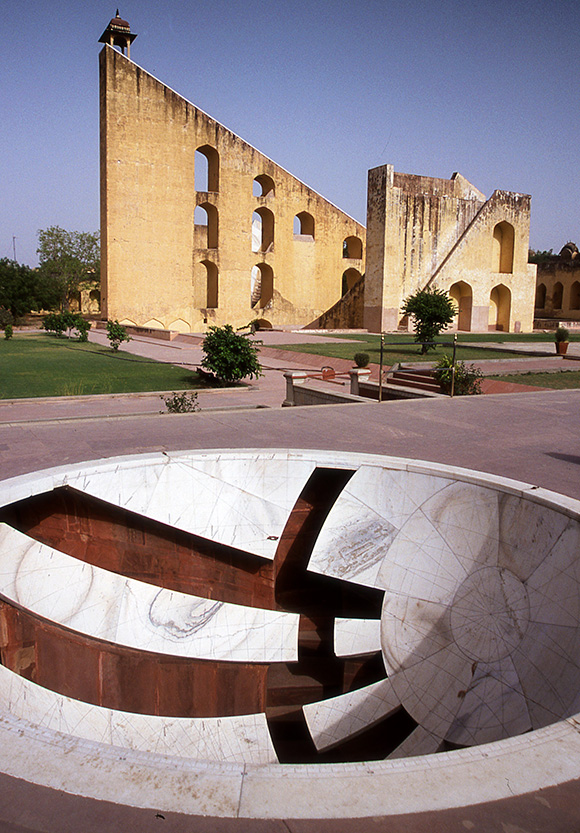aNewDomain.net — I love old, shiny science, from brass telescopes to astrolabes. The astrolabe dates back to 150 BCE (Before Common Era) and is a very ancient astronomical computer for solving problems relating to time and the position of the Sun and stars in the sky. It is so much more antique than the telescope of 1608 A.D. So why would a Maharaja build a naked eye observatory – no lenses, no moving parts – in eighteenth century India?
I am in Jaipur, in Rajastan — India’s first planned city. Locals call it The Pink City, as workers in fact painted it pink back in 1876 to welcome a visit by Edward, Prince of Wales. Jaipur is known for its fortress and palaces, some of which have been converted to luxury hotels, as you can see from some of my shots, below.
 Image credit: RUSS JOHNSON – THE CONNECTED TRAVELER
Image credit: RUSS JOHNSON – THE CONNECTED TRAVELER
But it is also home to a giant observatory without telescopes named Jantar Mantar.
I check into what used to be a sultan’s summer home, now a hotel, humming Judy Garland’s “Unless You Played the Palace,” and head off to Jantar Mantar.
 Image credit: RUSS JOHNSON – THE CONNECTED TRAVELER
Image credit: RUSS JOHNSON – THE CONNECTED TRAVELER
Jantar Mantar (“Formula of Instruments” in Sanskrit) is a collection of some fourteen astronomical devices built by the Maharaja Jai Singh II between 1727 and 1734. This Maharaja actually built five observatoties across India but the one in Jaipur is the best preserved and is a UNESCO World Heritage Site.
It is a garden of strange architectural delights.
Singh’s passion was astronomy. He amassed scientific manuscripts from the Middle East, Greece, Turkey and Europe, going all the way back to Ptolemy. A geek on an elephant, he also collected telescopes and astrolabes, even though his observatories, borrowing designs from the Persians and Greeks, were strictly for the naked eye.
Why? Ego, perhaps, certainly power. Scholars say they were monuments to the Maharaja’s authority: he could control the time, predict the future.
 PHOTO: RUSS JOHNSON – THE CONNECTED TRAVELER
PHOTO: RUSS JOHNSON – THE CONNECTED TRAVELER
Towering above the complex is the Samrat Yantra, at more than 70 feet, the world’s tallest sundial. The cupola on top was used as a platform for announcing eclipses and monsoons.
The Jai Prakash is an in-ground sundial based on a 300BC Greco-Babylonian design. You find the same style in European churches built in the Middle Ages.
The Maharaja was a man of the world.
 Photo Credit: Russ Johnson for The Connected Traveler
Photo Credit: Russ Johnson for The Connected Traveler
Ten smaller structures stand on their own, lined up to sight the positions of particular constellations and meaningful signs of the Zodiac.
The resident astronomers were masters of Jyotisa, or Vedic, astrology. There is actually an Android app to find out more about Vedic astrology.
Despite modernization, as it is in the Western world, astrology remains a part of Hindu culture. After a battle similar to the evolution vs creationism wars still going on in the conservative regions of the U.S., astrology is now officially a science in India.
In the early 2000s, a government ministry proclaimed that astrology be added to the university curriculum. One scientist famously howled that it was a “giant leap backwards” but he lost the argument. In 2011 the Bombay High court reaffirmed astrology’s standing as a four thousand year-old so-called “trusted science.”
Today astrologers are still flogging their cobra oil at the Jantar Mantar, claiming they can predict the weather and the crops.
Jantar Mantar has been used as a backdrop in several films and was the subject of a 1964 Bollywood Movie.












